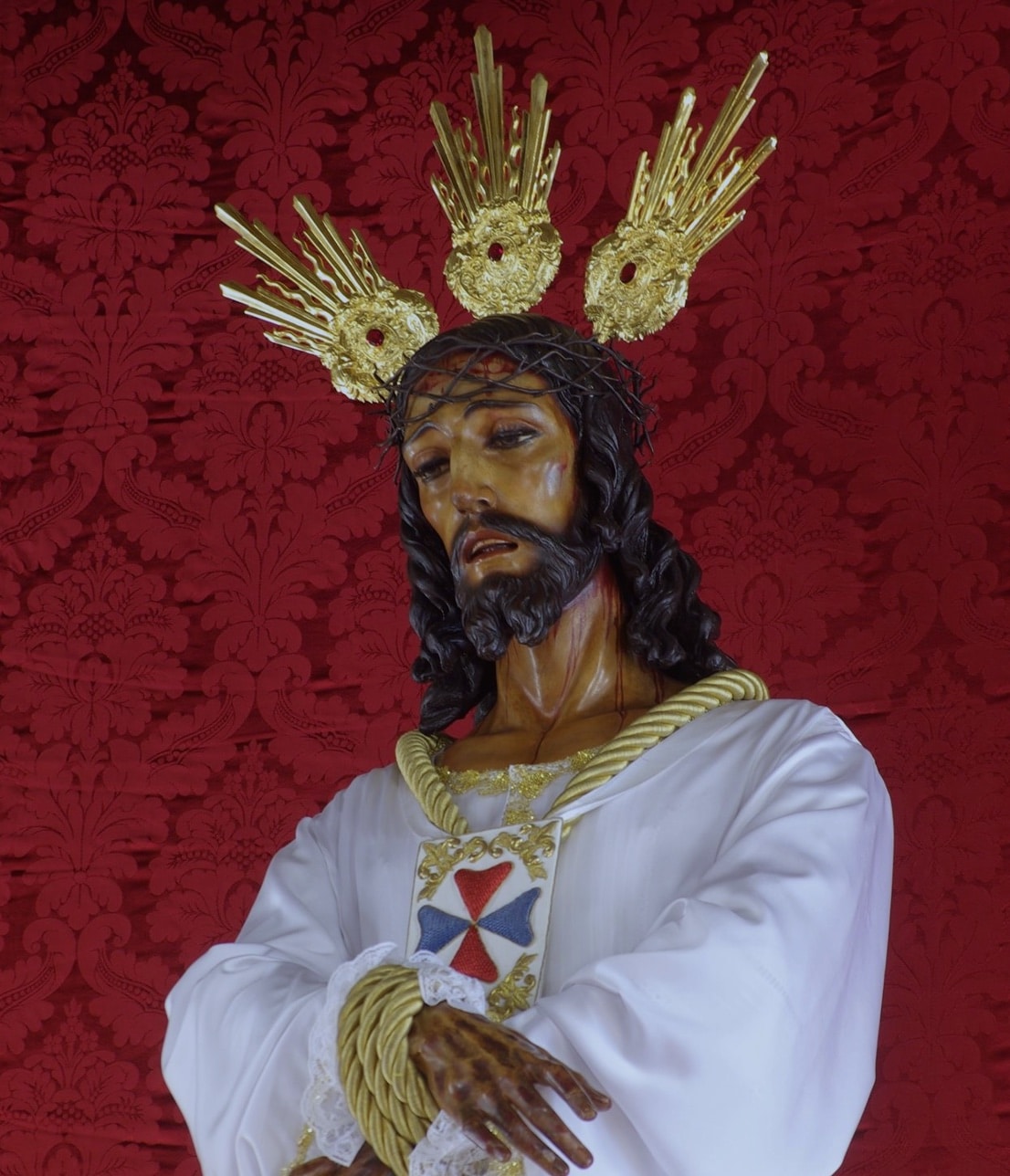Our Father Jesus the Captive – commonly known as <em>El Cautivo</em> – is one of the most notable works of José Gabriel Martín Simón and the most venerated image of the people of the Andalusian city of Málaga.
Martín Simón created the life-size statue of Christ for the recently formed <em>Hermandad de Jesús Cautivo</em> (Brotherhood of Jesus the Captive) society in 1934. The brotherhood began among school friends from the Ave María School in Trinidad, a working-class district of Málaga, under the spiritual direction of the school’s chaplain, Padre Antonio Hidalgo Vilaret. Originally centred on the image of <em>María Santísima de la Trinidad</em>, it emerged during a time of profound spiritual unrest in Spain.
A period of intense turmoil had led to civil war in 1936, and Málaga quickly became a hotspot for anti-clerical riots, resulting in the burning of churches, convents and monasteries. That year, the image of María Santísima de la Trinidad had to be hidden in one of the founders’ homes to prevent its destruction. The city suffered some of the worst atrocities of the period – the following year, in February 1937, the Málaga–Almería road massacre killed thousands and remains etched into the cultural memory of the city's citizens to this day.
It is out of trauma, and the longing for peace, redemption and reconciliation, that <em>El Cautivo</em> was born. Martín Simón was commissioned to create the statue, and in 1939 it was formally incorporated into the brotherhood.
Today, its significance among the population of Málaga is difficult to overstate. A friend once told me that, despite not being baptised, he always goes to see <em>El Cautivo</em> during Holy Week. When Málaga FC recently won a match that led to their promotion to the second division, the entire team – including the mascot – made a pilgrimage to visit the sacred image and give thanks.
Despite knowing all this – and knowing that if the Spanish like anything, it is a good procession – I drove to Málaga on Holy Monday expecting to be able to see <em>El Cautivo </em>as he made his dramatic entrance into the city centre from his native church in the suburbs.
Miraculously managing to find parking, I heard the slow tempos and powerful brass and percussion that I’ve come to associate with processional marches on the Iberian Peninsula. I then saw the penitents, dressed in penitential purple, and expected to see the floating image of <em>El Cautivo</em> behind them. It was certainly a splendid image of Christ – but it was not The Captive.
Three hours later, having negotiated most of the crowded streets of central Málaga and seen many beautiful statues of Christ and the Virgin, <em>El Cautivo</em> remained elusive. Admitting defeat, I decided to return home – via a detour to visit a Spanish friend who was perched in a café and whose tactic to see <em>El Cautivo</em> was to encounter it at the unholy and, on a Monday evening, exclusively Spanish hour of 11 p.m.
On the way, however, something of an Andalusian miracle happened. I found myself jammed on a street just a couple of minutes away from the café, but completely deadlocked. I decided to wait it out rather than find another route – displaying an uncharacteristic stoicism.
As I waited, I felt the tension of the crowd rising. People seemed anxious to move forward, and the woman in front of me began cursing those ahead. Hearing the familiar music and expecting to see another float, it was a joy – and something of a surprise – to see <em>El Cautivo</em> appear at the intersection at the end of the street, in his strikingly white robes. A round of applause and gasps of appreciation added to the sense that we had all witnessed what we had come for, and I spontaneously exclaimed – not in my usual vernacular – “<em>¡Qué bueno!</em>”
Spanish Catholicism, in all its demonstrative splendour, can sometimes feel alien to the outsider. The displays of emotion and excess, along with the elaborately robed statues and near-constant disruption to the working week, are particularly foreign to British sensibility. It is far from Newman’s "Lead, Kindly Light" and the 9 a.m. Mass.
However, it is also a poignant reminder of why we need images – cultural or otherwise. <em>El Cautivo</em> represents so much: a city’s pride, a nation’s Catholic devotion, the suffering of war, and a reliance on the One who gave it all.
As we see the resurgence of British Catholicism this Easter and in its aftermath – and who knows what the impact of the death of Pope Francis and the accompanying coverage may have – with thousands entering the Church, perhaps the time has come for Britain’s own <em>El Cautivo</em> to rise.
Though it will take a lot to match Martín Simón’s creation, and still more so when it comes to Málaga’s devotion to it.
<em>Photo: 'El Cautivo'. (Credit: Málaga Holy Week Brotherhood Association</em>.)



